EXTENDING THE DEDHAM VALE AREA OF OUTSTANDING NATURAL BEAUTY (AONB)
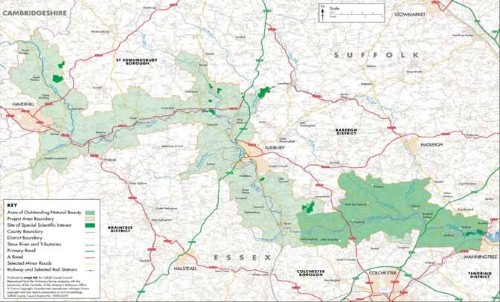
Map showing the area of outstanding natural beauty to the right. The long term aim is to extend the AONB up to Haverhill. However the next application will be from Wormingford to south of Sudbury.
Summary
The existing Dedham Vale AONB should be extended a few miles further upstream in the Stour valley towards Sudbury to include the hilly areas around the picturesque villages of Bures, Lamarsh, Alphamstone and Henny.
This has been proposed before and until 1991 much of the area was designated Potential AONB. The key arguments for this extension are: 1. The area can be shown to meet the criteria of Outstanding Natural Beauty as laid out in Section 82 (1) of the Countryside & Rights of Way (CROW) Act 2000.
2. The area has always been known for its gentle farmed landscape qualities and was the subject of paintings by Thomas Gainsborough, John Constable and other famous artists.
3. The area has been greatly enhanced in the past two decades by farmers adopting the various countryside stewardship schemes to help fund a wealth of hedge planting, pond restoration, woodland creation and other conservation measures.
4. This proposal has the support of all local authorities including Essex and Suffolk County Councils and has been proposed to Natural England, the regulatory body which makes the designation.
5. The proposal is now urgent as National Grid is in the throes of decisions on the forthcoming new East-West power lines that will cross the valley. It has already agreed to underground the new lines across the Stour Valley; itself a recognition of the area’s exceptional natural beauty – but funding to underground the existing 400kV structures at the same time will only be possible, as things stand, if the area has AONB status.
The Role of AONBs
The main reason why AONB status is so important is that it gives much enhanced protection to the countryside. This does not mean that no development is ever allowed, but controls on quality are tighter and any changes should be appropriate to the landscape character. Other beneficiaries from AONB status include all who rely on tourism such as pubs, bed & breakfast accommodation and local shops. It can also include priority areas for environmental schemes delivered by farmers. Existing property values should also benefit from the restrictions on further development. Funds are available to help with environmentally friendly community and economic projects and can be given to remedial activities such as undergrounding low voltage wires and, in some cases, associated telephone lines.
The recent changes in planning legislation confirm protection for AONBs but make development, which may or may not be appropriate, much easier elsewhere. It is instructive to read the document “Designation History Series, Dedham Vale AONB” which gives a clear account of the lengthy process required to achieve AONB status. It was produced in May 2010 by Natural England, the Government’s advisor on the natural environment, and details the steps showing how and why these areas were added to the original AONB.
The Dedham Vale AONB
The Dedham Vale was first designated as an AONB in 1970 and there have been only two extensions since. The first added a small area consisting of Shelley and Raydon in 1978.
From the same year, the Dedham Vale Society, the Colne Stour Countryside Association and local authorities, notably Essex and Suffolk County Councils, campaigned for AONB status to be granted to an area comprising Nayland, Wissington, Wormingford, Bures, Mount Bures, Lamarsh and Alphamstone, all of which were given the official designation “Potential AONB”. After a series of inspections, meetings and much correspondence over a decade or more, the Countryside Commission, the body that at that time had the power to designate land as AONB, decided to recommend only the small extension including Nayland, Wissington and Arger Fen, of six and a half square miles. Its report speaks of “degradation in the landscape” beyond this point and the character of the valley being different to the area recommended. The designation “Potential AONB” was removed in 1991 and we were told that evidence of substantial improvement in landscape quality would be needed before the Countryside Commission decision could be reviewed. My own opinion is that the Commission, and in particular the employee, who made the recommendations, never visited the enchanting, often hidden, side-valleys on both sides of the river which frequently amaze visitors by their exquisite and unexpected delicate beauty.
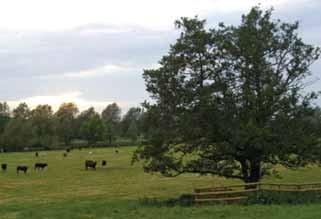
245 acres of grassland.
Changing farming practices in the area However, in the main valley, the Commission had a point. As with all arable land, the 1970s and 80s were a time when most farmers had little regard for the environment. Many ancient boundary hedges had been ripped out without any understanding of their antiquity or importance. Ponds had been filled in, public footpaths ploughed up and fields were cultivated to the tarmac on country lanes.
But perhaps most damaging to the landscape and to the reputation of farming was the widespread practice of burning straw after harvest. Indeed, the Stour Valley from the top of Wormingford Hill sometimes looked as if it was the film set for the Battle of Stalingrad with fires and columns of smoke as far as the eye could see and often burning woodland and hedgerows as well. The resulting dirt and damage to households, hospitals, schools and businesses, particularly after the 1989 harvest, provoked a furious reaction from town and country people alike and stubble burning was finally banned by John Gummer (now Lord Deben) when Minister for Agriculture from 1992 onwards.
That was over 20 years ago and much has changed. 30 years of happy conservation!

30 years of happy conservation!
A 38 page document from Natural England entitled “Guidance for Assessing Landscapes for Designation as National Park or Area of Outstanding Natural Beauty in England” sets out in detail what is required. The formal wording is: Section 82(1) of the Countryside and Rights of Way Act 2000 ( ?CROW?) defines an AONB in England as an area that is not in a National Park but which appears to Natural England to be of such outstanding natural beauty that it is desirable that the protective provisions of Part IV of CROW should apply to it for the purpose of conserving and enhancing the area‘s natural beauty. In such circumstances Natural England may, by order, designate the area as an AONB.
Beauty as such is not precisely defined but the factors to be considered are landscape quality, scenic quality, relative wildness, relative tranquillity, natural heritage features and cultural heritage. The Guidance defines this as “the influence of cultural heritage on the perception of natural beauty of the area and the degree to which associations with particular people, artists, writers or events in history contribute to such perception.” The fact that, as in our case, the landscape is entirely man-made over the centuries is understood. It is worth studying the detailed criteria but in my view, the Stour Valley ticks all the boxes even though more remains to be done. The concerns of the Countryside Commission of two decades ago have been addressed.
There has been new legislation such as the CROW Act but as important has been the change in farmers’ attitudes to environmental factors and the realisation that the overwhelming majority, who are not farmers, want the landscape to look attractive as well as be productive.
Attitudes have been helped by programmes such as the Environmentally Sensitive Area Scheme (ESA) for the Suffolk River Valleys, introduced in 1987 and Countryside Stewardship, introduced in 1992 both of which gave financial support to landowners who were prepared to put part of their land into agri-environmental schemes. These involved wildflower meadows and other attractive options which were particularly encouraged in Suffolk river valleys. It is interesting to note that the ESA scheme encompassed the Stour Valley to Sudbury to include both the Dedham Vale AONB and the area which is the subject of this paper.
From 2007, the programme of Environmental Stewardship was introduced on two levels. The simplest is called Entry Level Stewardship where in return for modest payments, farmers commit to a range of options to improve the landscape. For example, letting taller and wider hedges grow up and sowing grass margins (formerly known as headlands) around arable fields are amongst the most popular. Nearly all farmers in the Stour Valley have joined this scheme and the benefits are already apparent.

Hazel hedges to improve the landscape.
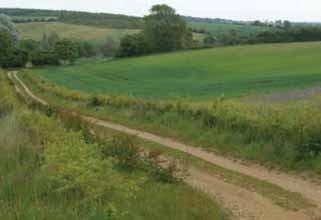
Approximately 7 miles of hedges planted.
Phacelia, borage and clover strips to attract wildlife. Five acre lake and conservation washland created in 2001. New homes to swans, geese, ducks, widgeon, snipe, coots etc. Many farmers in the Valley are also enrolled in the Higher Level Stewardship Scheme (HLS). This is considerably more demanding in terms of land management and there are many options, all of which raise the quality of the landscape from an environmental viewpoint. HLS is a ten year commitment and is not automatically awarded. In fact Natural England, which administers the scheme, has concentrated resources in this region on the Stour Valley and the impact has been significant.

Phacelia, borage and clover strips to attract wildlife.
Many miles of hedgerows and acres of woods have been planted, ponds have been restored and most arable fields now have a two, six or sometimes ten metre margin, often set with native wild flowers and which encourage songbirds and other wild life. A number of landowners have undergrounded telephone and low voltage electricity cables. Many of the old water meadows which were ploughed up in the era of intensive farming have been returned to their original condition and, taken as a whole, the landscape quality has been transformed for the better over the past twenty years.
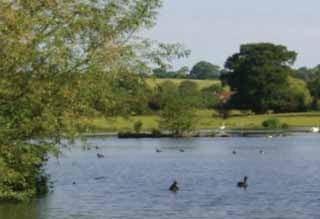
Five acre lake and conservation washland created in 2001.
New homes to swans, geese, ducks, widgeon, snipe, coots etc. Dedham Vale AONB & Stour Valley Project Partnership
Another important factor has been the work of the Dedham Vale AONB & Stour Valley Project Partnership (the Project) which was set up in 1981 with responsibility for the AONB.
The Project area was extended in 1988 and 1992 to include the Stour Valley right up to the headwaters of the river at Great Bradley in Cambridgeshire (see map). The Project is funded by DEFRA (Department of the Environment, Food and Rural Affairs) and also by Essex and Suffolk County Councils, Colchester and St Edmundsbury Borough Councils and Babergh, Braintree and Tendring District Councils. The Project joint managers are Katherine Potts and Simon Amstutz, both highly experienced and effective, who with their small staff and large number of volunteers have done wonderful work throughout the valley. If the AONB is to be extended, the new area will have to have a formal management structure. In our case it already exists and is working to good effect with local farmers and others. The case for extending the AONB is already known, understood and supported by all the official bodies concerned because local authority Councillors and Officers work together on the Project Joint Advisory Committee and Partnership. It was at a meeting of the Project Partnership in November 2009 that the resolution was passed “to issue a statement of intent to Natural England seeking an Extension of the Dedham Vale AONB, including westward towards Sudbury and to evaluate and provide a substantive case and detail in support of an extension.” This intention has been incorporated in the area’s Management Plan 2010-2015 and acknowledged by Natural England as one of a number of requests for boundary changes put to it. The strong support of local authorities is vital and this has been forthcoming both from Councillors and Officers, with Suffolk County Council taking the lead. An AONB is a legal entity for which the local authorities concerned have to take responsibility and meet certain requirements laid down by Acts of Parliament. In straightened economic times further spending commitments will be unwelcome so it will be necessary for funding to be realised from other sources. This will present difficulties but they can be surmounted. For example, Managing a Masterpiece, funded mainly through the Heritage Lottery Fund, (whose work is described elsewhere in this magazine), has raised the profile of the Stour Valley through its wide range of projects, not least the understanding of local history and archaeology.
Other supportive factors for granting the area AONB status
A further key factor has been the research which has identified works by major artists notably Thomas Gainsborough and John Constable in the area. Specific views by Gainsborough in Henny, Lamarsh and Bures have been identified and Constable’s connection with Bures, where his grandfather was miller have shown he was active in this section of the valley, with his painting Lamarsh Hall (actually Daws Hall), a well-known example. The wealth of Grade 1 and Grade 2 listed buildings has also been highlighted.
In the years since 1992 there has been only a modest amount of development in the area. A few regrettable farm buildings have been more than balanced by some sensitive restorations. For example the ugly cheese factory in Bures with its industrial chimney has been replaced with a charming housing development which blends in well with the historic Church Square. Essex and Suffolk Water has built a pumping station near Bures, effectively disguised as a large Essex barn. The few telephone masts in the valley may become redundant as technology makes them unnecessary. Even the prominent masts at Assington with their red lights at night will probably be needed for only a few more years, and their removal will be welcome.
The river itself was also degraded in the late 1960s by Anglian Water building dykes from Bures to Sudbury, ostensibly to prevent flooding. Under the Water Framework Directive (to improve the ecological status of water bodies) the Dedham Vale AONB & Stour Valley Project are now looking at some potential river improvement and restoration schemes.
National Grid powerline plans lend urgency to the issue of AONB status
The major issue over the last three years, however, has been the intention by National Grid (NG) to build a new 400kV power line from Bramford to Twinstead. After consulting widely, NG has decided to place the new line underground across the Stour Valley, the first time that it has agreed to do so outside an urban area, AONB or National Park which is recognition of the scenic, cultural and historic quality of the landscape.
The older, 132kV overhead line is to go and the pressure will now be on to get the existing 400kV power line undergrounded at the same time as the new one is installed. The removal of these eyesores would be a huge benefit and restore the timeless integrity of the valley.
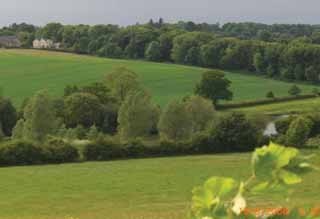
Electricity lines buried at Chapel Meadows.
However, the immediate problem is that, although NG has been told by its regulator OFGEM that £500million can be spent on remedial work undergrounding unsightly overhead lines, it applies only in AONBs and National Parks. This unique opportunity to get rid of such horribly damaging structures will be lost unless either the rules are changed or the Stour Valley achieves AONB status. As work is planned to begin in 2016, time is very short.
Conclusion
Because of this dilemma, I believe it is now urgent that AONB status should be sought for the Stour Valley from its present boundary to a line South of Sudbury, probably to include parts of Little Cornard, Henny and Twinstead. A Landscape Character Assessment will be required, not least to recommend exact boundaries, although much of the detailed work has already been done by other bodies. Approaches have been made to people who could undertake further work, and it is conceivable that funds could be raised from sympathetic organisations and local residents to pay for the survey.
Subject to the conclusions of the resulting report, the case can then be made to Natural England and, provided there are no last minute objections, a public enquiry will not be required.
I am confident that Natural England’s demanding criteria can be met and we must hope that the urgency of our case can persuade it to allow our application to go forward alongside that of Suffolk Coasts & Heaths AONB who are hoping to have the South bank of the Stour Estuary included and which is now near the top of the queue. The wholehearted backing for this vision from all concerned will be a key factor in realising our goal.
Robert Erith
Robert Erith has lived in Lamarsh overlooking the Stour Valley since 1966. He is President of The Dedham Vale Society and on the Committee of the CSCA. His farmland is mostly within the proposed extension of the AONB and in recent years he has joined the Higher Level Stewardship Scheme. He has replanted hedgerows and added many trees, mainly oak. Geoffrey Probert , who lives at Bevills, Bures, has provided all the pictures for this article and, as can be seen, he has transformed his land so that it now adds to the scenic value of the proposed extension of the AONB.
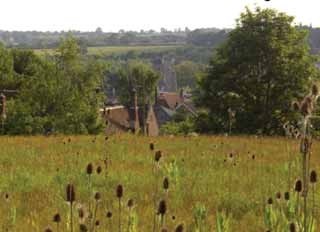
Bevills Farm sits on the bend of the Stour river around Bures village.

